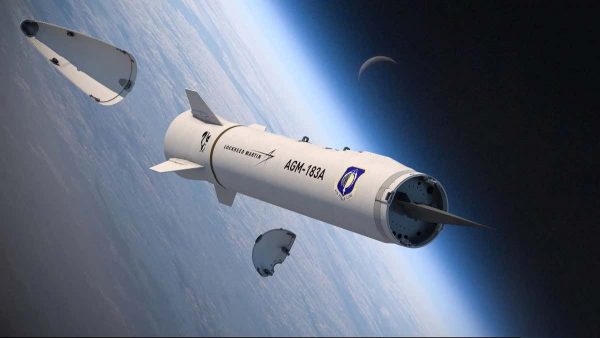China has reportedly achieved a breakthrough in its research into hypersonic missile technology, which could give the communist country a decisive edge over its arch-rival US.
Pakistan ‘Races Ahead’ Of India In Drone Technology; Is 4th Country To Deploy UCAVs In Combat Ops
Inspired By F-22 Raptor, China’s New Carrier-Borne Fighter Jet Aims To Overpower US Navy’s F-35, F-18 Super Hornets
Hypersonic weapons, capable of traveling at five times or more the speed of sound (minimum speed of 1.6km per second), are the new focus of the global arms race. The US, Russia, and China are developing and testing these ultra-fast munitions, with the latter two being far more successful.
Moscow and Beijing have so far been locked in a tight neck-to-neck race. However, with the researchers from the People’s Liberation Army (PLA) recently revealing technological improvements they’ve made, China might have gained an edge in this arena of weapons.
It could soon be applying the hypersonic speed capability to arms other than missiles!
China’s Hypersonic Arsenal
Hypersonic weapons are of two types: hypersonic cruise missiles and hypersonic boost-glide vehicles. The former type is powered by rockets or jets throughout their flight and is a much swifter version of existing cruise missiles.
The latter type is launched into the upper atmosphere on top of existing ballistic missiles, and then releases hypersonic glide vehicles (HGVs) which fly lower, faster, and, to an enemy, quite unpredictably.
China has two lethal hypersonic missiles. The first one, Dong Feng-17 (DF-17), is a medium-range missile or MRBM system equipped with an HGV. It is capable of carrying conventional or nuclear weapons and has a reported speed of Mach 5-10.

With a range of 1,800-2,500km and a launch weight of 15,000kgs, the DF-17 is a nightmare for all adversaries. However, this missile’s status remains unclear, although its appearance in China’s October 2019 military parade has raised speculation that it may have entered PLA service.
Role Reversal For F-16 Fighter Jet As US-Origin Attack Aircraft Could Be Used As ‘Drone Bodyguard’ By Turkey
The second is the DF-ZF HGV that can travel at speeds between Mach 5-10. It is apparently capable of performing “extreme maneuvers” to evade enemy defenses. The DF-17 has been designed to work specifically with the DF-ZF, exponentially amplifying both these weapons’ powers.
The DF-11 and DF-15 are also expected to be capable of operating with this glider.
A Major Breakthrough
There has been a growing interest in applying hypersonic technology to drones and other military aircraft, especially jets. However, for such vehicles, landing on airstrips, especially when they have been traveling at close to 5 times the speed of sound, is exceptionally difficult.
Doing such a landing in dangerous and immediate military settings is even harder.
Software, which often helps find the optimum path for descending for aircraft, becomes somewhat redundant when the computations need to be done for a vehicle moving at hypervelocity. This has been a major roadblock for further developing the hypersonic technology for both Beijing and Moscow.
Seems to be a another glider warhead, similar to that on DF-17, atop a rocket for a DF-21 size missile. pic.twitter.com/hLk5dYt6oq
— LIX (@lix123) October 11, 2019
However, the South China Morning Post reported that researchers from the People’s Liberation Army (PLA) Air Force have made improvements to the software. Their research paper was published in a peer-reviewed journal, Tactical Missile Technology.
These enhancements have been made based on a classified model of a hypersonic drone that China has been developing. Details regarding this ultra-swift drone are not known yet, the paper at least confirms its existence.
There are doubts that this might be the rocket-propelled drone Wuzhen 8, which, although is believed to fly faster than sound, isn’t confirmed to be hypersonic yet.
WATCH: Chinese J-10, J-16 Fighter Jets ‘Battle For Dominance’ Against Russian Sukhoi Su-35 Aircraft
The Chinese researchers’ innovation, where they focused on improving the software rather than the power of onboard computers, is likely to be revolutionary. Since the computer can still not process all collected data fast enough to predict a landing course, the software will use the changing air pressure and altitude to choose one of three models for the final descent approach.
Shutting down the drone’s engine in advance and make it do maneuvers to slow its momentum could assist in the landing.
A futuristic technology that can take on even the strongest stealth fighters such as the F-22, simply due to overwhelming speed, seems to be in the making.
BIG SETBACK: China’s Very-Own Version Of US Predator Drones ‘Falling Apart’ In Global Sales & Reputation?
Russian Hypersonic Missiles
Russia has three major hypersonic weapons — the Avangard, the Kinzhal, and the Zircon — which President Vladimir Putin has dubbed “invincible”. And all of them cleared tests.

Last month, Colonel-General Vladimir Zarudnitsky, Chief of the Military Academy of the Russian General Staff, disclosed details about a new missile, Kh-95 or the X-95, according to The Eurasian Times.
Russian news agencies like RIA Novosti and TASS confirmed the existence of the missile with Novosti reporting that the Kh-95 will be compatible with the Tu-23M, Tu-160M, and Russia’s upcoming PAK-DA bomber.
In July this year, the Russian Admiral Gorshkov frigate had successfully test-fired the Tsirkon (Zircon) hypersonic missile against a surface target at a range of over 350 km and the flight speed reached 7 Mach, the Russian Defense Ministry was quoted as saying by RIA Novosti.

In June, reports emerged that two MiG-31 K fighter jets capable of carrying Kinzhal hypersonic missiles have been deployed in the Khmeimim airbase in Syria.
Compared to Russia and China, the US is lagging in hypersonic technology. In July, the US Air Force’s second attempt to conduct the flight test of a hypersonic weapon proved to be a dud.
The test involved a prototype of the AGM-183A Air-launched Rapid Response Weapon (ARRW), a hypersonic missile. The missile was able to successfully separate from the B-52H bomber which was carrying it, however, the rocket engine did not ignite.
— With inputs from Shreya Mundhra




